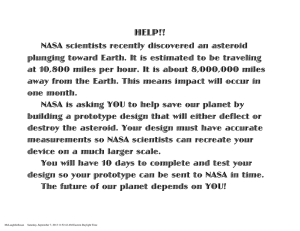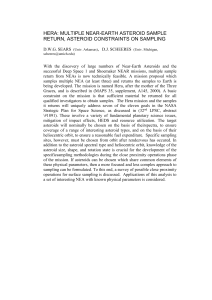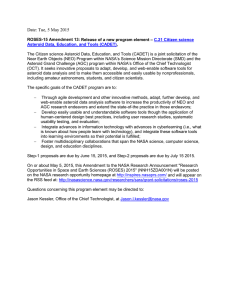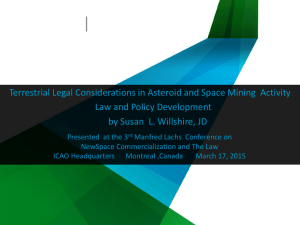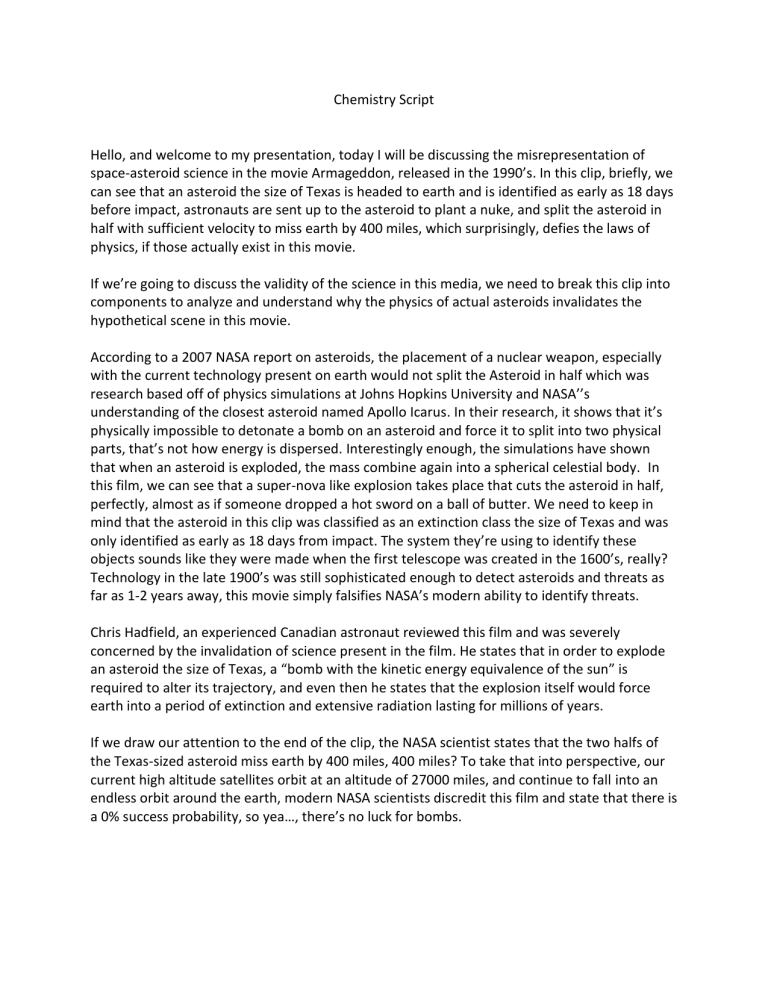
Chemistry Script Hello, and welcome to my presentation, today I will be discussing the misrepresentation of space-asteroid science in the movie Armageddon, released in the 1990’s. In this clip, briefly, we can see that an asteroid the size of Texas is headed to earth and is identified as early as 18 days before impact, astronauts are sent up to the asteroid to plant a nuke, and split the asteroid in half with sufficient velocity to miss earth by 400 miles, which surprisingly, defies the laws of physics, if those actually exist in this movie. If we’re going to discuss the validity of the science in this media, we need to break this clip into components to analyze and understand why the physics of actual asteroids invalidates the hypothetical scene in this movie. According to a 2007 NASA report on asteroids, the placement of a nuclear weapon, especially with the current technology present on earth would not split the Asteroid in half which was research based off of physics simulations at Johns Hopkins University and NASA’’s understanding of the closest asteroid named Apollo Icarus. In their research, it shows that it’s physically impossible to detonate a bomb on an asteroid and force it to split into two physical parts, that’s not how energy is dispersed. Interestingly enough, the simulations have shown that when an asteroid is exploded, the mass combine again into a spherical celestial body. In this film, we can see that a super-nova like explosion takes place that cuts the asteroid in half, perfectly, almost as if someone dropped a hot sword on a ball of butter. We need to keep in mind that the asteroid in this clip was classified as an extinction class the size of Texas and was only identified as early as 18 days from impact. The system they’re using to identify these objects sounds like they were made when the first telescope was created in the 1600’s, really? Technology in the late 1900’s was still sophisticated enough to detect asteroids and threats as far as 1-2 years away, this movie simply falsifies NASA’s modern ability to identify threats. Chris Hadfield, an experienced Canadian astronaut reviewed this film and was severely concerned by the invalidation of science present in the film. He states that in order to explode an asteroid the size of Texas, a “bomb with the kinetic energy equivalence of the sun” is required to alter its trajectory, and even then he states that the explosion itself would force earth into a period of extinction and extensive radiation lasting for millions of years. If we draw our attention to the end of the clip, the NASA scientist states that the two halfs of the Texas-sized asteroid miss earth by 400 miles, 400 miles? To take that into perspective, our current high altitude satellites orbit at an altitude of 27000 miles, and continue to fall into an endless orbit around the earth, modern NASA scientists discredit this film and state that there is a 0% success probability, so yea…, there’s no luck for bombs. So how does science affect us? How do we change as a result of misrepresented science portrayed in movies like Armageddon. Well, Hollywood has had a great reputation for sugar coating science and introducing make-belief concepts that are non-existent in our current period in time despite it all being non-fiction which negatively affect the cognition of not only common viewers, but young scientists progressing in their careers. According to Margaret McCartney, a contributor to the British Medical Journal These misleading, overblown, and simplified stories do little to improve the scientific literacy and knowledge of young scientists and citizens. Instead, they risk creating confusion and disenchantment about research.” Most of the causation to the misinterpretation comes with the lack of education which seems to be the case in this film. I mean, in the movie, it’s clear that there’s a high level of realism in terms of how the misrepresented science is portrayed which is an aspect that appeals to the senses of its audience, striking belief that we can simply explode extinction-class asteroids with nuclear weapons. It’s obvious that films that portray space and time are exaggerated, simply to portray thrill and action; however, the implication is that people that do not have specific scientific background or knowledge will understand space in a falsified manner, and judging by the expensive cgi in this film, It would’ve fooled me. Thank you for listening to my presentation!
